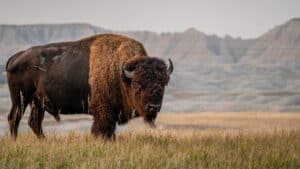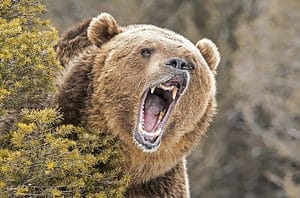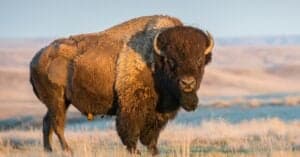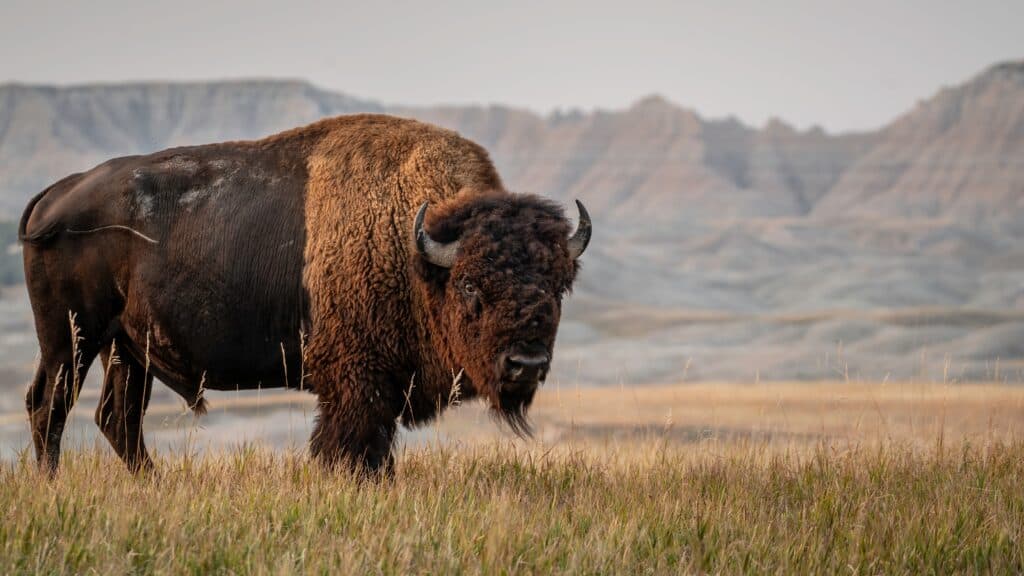
Discover where the oldest and largest bison herd in the U.S. resides.
©Tim Malek/Shutterstock.com
Where is the Oldest and Largest Bison Herd in the United States?
One of the largest and oldest bison herds in the U.S. is found in Yellowstone National Park, the only country where bison have lived since prehistoric times. While Yellowstone bison are usually considered the largest herd in the country, this is only partially true. Yellowstone bison comprise the largest herd on public land, but the largest bison herd on private land measures nearly eight times larger than the Yellowstone bison population.
Approximately 5,900 individuals roam freely Yellowstone’s land. These bison are split into two main herds: a central herd and a northern herd. The northern bison herd is significantly larger than the central herd, with 4,460 members. On the other hand, the central herd only claims around 1,360 members.
Bison in Yellowstone frequent Hayden Valley and Lamar Valley year-round. Lamar Valley is the best place in Yellowstone to see bison. Bison in Lamar Valley dot the landscape by the hundreds, often grazing near roadways or crossing roads. Their proximity to roadways in Lamar Valley allows the best viewing for visitors. During summer, bison also roam the grasslands of Yellowstone. Winter forces the bison into warmer habitats, such as hydrothermal areas.
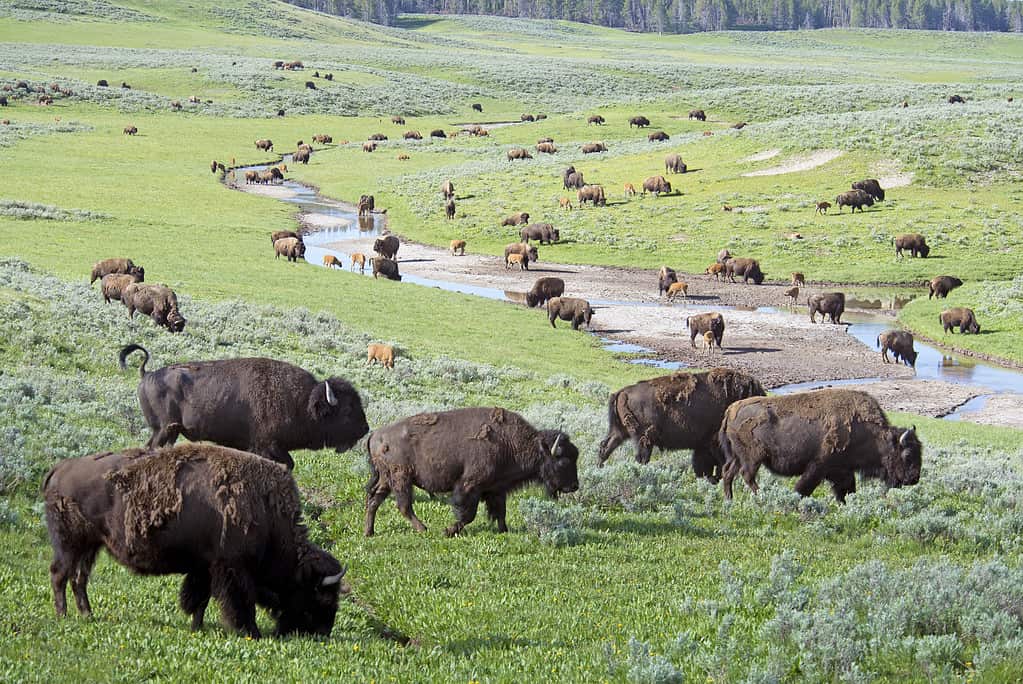
The largest and oldest bison herd on public land in the U.S. is found in Yellowstone National Park.
©iStock.com/Betty4240
Where Were Bison Found Before They Arrived in Yellowstone?
Before recording their largest numbers in Yellowstone National Park, bison roamed across North America in massive herds. Their population once numbered in the tens of millions. Bison were an essential aspect of Native American culture. Native Americans saw the bison as a primary food source and used every part of the bison to make home goods, tools, and medicine. Interestingly, the hunting of bison by Native Americans never threatened bison population numbers. The natives knew how to hunt bison conservatively and respectfully.
When Europeans began settling in the West, they became frustrated with Native Americans’ presence. As a result, Europeans began killing off the main food source of the natives, bison, hoping to push these original people groups from their land.
Some European hunters saw bison as a precious commodity. These hunters would kill bison in great numbers for their hides, significantly reducing the bison population. European hunting techniques and disregard for natural life on the plains propelled Yellowstone managers to make conservation efforts toward preserving bison populations.

Bison served as a main food source for Native Americans before Europeans settled in the West.
©Cavan-Images/Shutterstock.com
How Did Bison Arrive in Yellowstone National Park?
Before bison arrived in Yellowstone National Park, they numbered in the tens of millions across the entire North American continent. However, hunting and eradication efforts by European settlers significantly decreased their population numbers in the 1800s. By the 1880s, only around two dozen individuals remained in the Yellowstone area. While other bison herds were far more abundant on private lands, those left on public lands were in extreme danger.
As a result, Yellowstone proposed a way to conserve and protect bison populations. In 1902, 21 bison purchased from private owners were brought to Lamar Buffalo Ranch. At Lamar Buffalo Ranch, these bison were raised and bred to release them eventually into Yellowstone.
Once bison from Lamar Buffalo Ranch were released into Yellowstone to roam freely, bison populations within the park increased. By the mid-1950s, around 1,300 bison roamed freely throughout the park. This number would continue fluctuating and growing steadily to the 5,900 individuals within the park today.
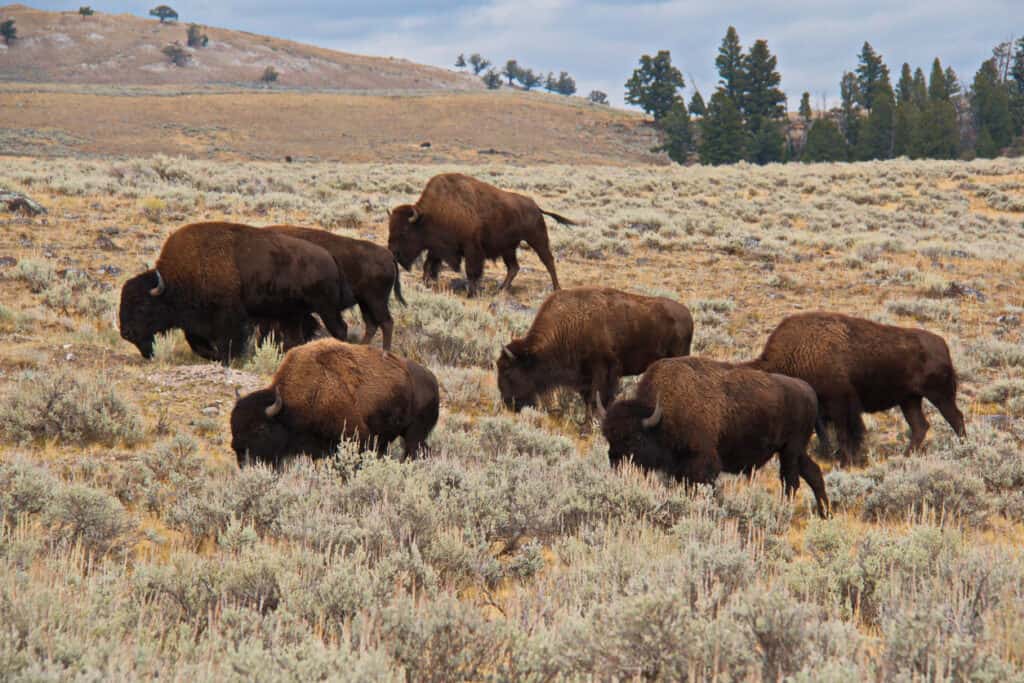
Lamar Buffalo Ranch helped reintroduce bison to Yellowstone National Park.
©iStock.com/Karel Stipek
Background on Bison
Bison are massive creatures, growing more than 6 feet tall with a length of more than 11 feet. They are the largest land-dwelling mammal in North America. Male bison, called bulls, weigh up to 2,000 pounds. Females, on the other hand, weigh about half as much as bulls.
The coloration of bison appears medium or dark brown, and their bodies showcase a thick fur coat on their head, shoulders, and forelegs. Male bison have longer horns than females, but the difference remains minimal. Despite their hulking size, bison can run up to 35 miles an hour. Additionally, they can swim well and jump up to 5 feet in the air.
Most bison live between 12 and 15 years, while some may live up to 20. Bison mating season occurs between July and August, and calves are born in the late spring. Calves typically feature a red or tan coloration at birth, which eventually fades to brown after a few months.
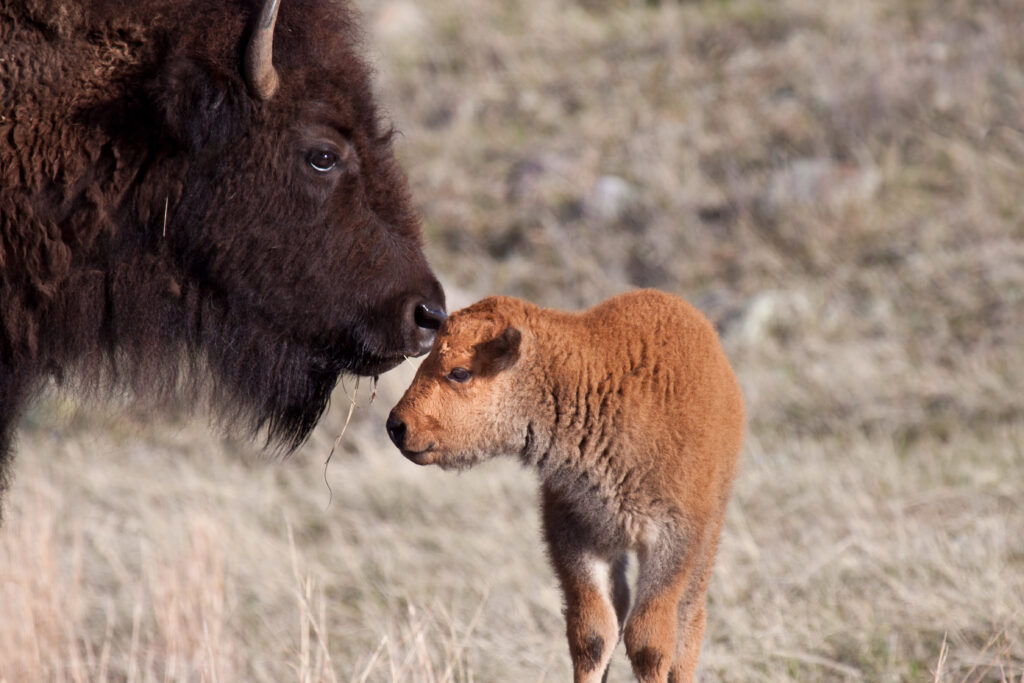
Bison calves typically appear red or tan directly after birth.
©Marcia Straub/Shutterstock.com
How to Observe Bison in Yellowstone National Park
Tourists of Yellowstone National Park are likely to see many bison throughout their visit. From the rolling hills of Lamar Valley to forested roadsides, bison roam everywhere in the park. While seeing bison up close is an incredible opportunity for visitors, safety should be the priority.
Visitors who see bison from their vehicles should use designated pullovers to observe the animals. Stopping vehicles in the middle of the road to view bison can cause traffic jams and be dangerous for animals and tourists. However, bison may cross the road in front of vehicles. In these instances, visitors should stop their cars, allowing bison to cross. Bison may cross individually or in groups, so tourists should be patient and will enable all bison to cross roadways before continuing to drive.
Finally, observers who view bison from outside their vehicles should always keep at least 25 yards of distance between themselves and the bison. Perhaps surprisingly, bison are responsible for Yellowstone’s most animal-related human injuries and deaths. Despite their calm and quiet demeanor, these creatures are powerful animals that should be left unbothered. Provoking a bison could cause it to become aggressive. As a result, the bison could charge and gore a visitor, leaving irreversible damage to the human. Park rangers encourage visitors to enjoy wildlife while keeping a safe and respectful distance.

Visitors observing bison should keep a safe distance between themselves and the herd.
©Tiffany Noel Videography/Shutterstock.com
The Largest Bison Herd on Private Land
The largest bison herd on privately owned land in the U.S. is on Turner Ranches. Turner Enterprises is owned by Ted Turner, one of the largest landowners in the country. He owns approximately 2,000,000 acres of land throughout the West, most of which is used for conservation and research.
Turner’s 14 ranches sprawl across six states, and within these ranches reside around 45,000 bison. Turner’s herd is one of the largest privately owned herds in the world! Most bison on Turner Ranches roam freely, grazing on many acres. Turner also participates in the bison meat industry. While many might believe that selling bison meat harms the species, it can help conserve it. Responsible bison meat production allows for healthier and happier bison herds in the future.
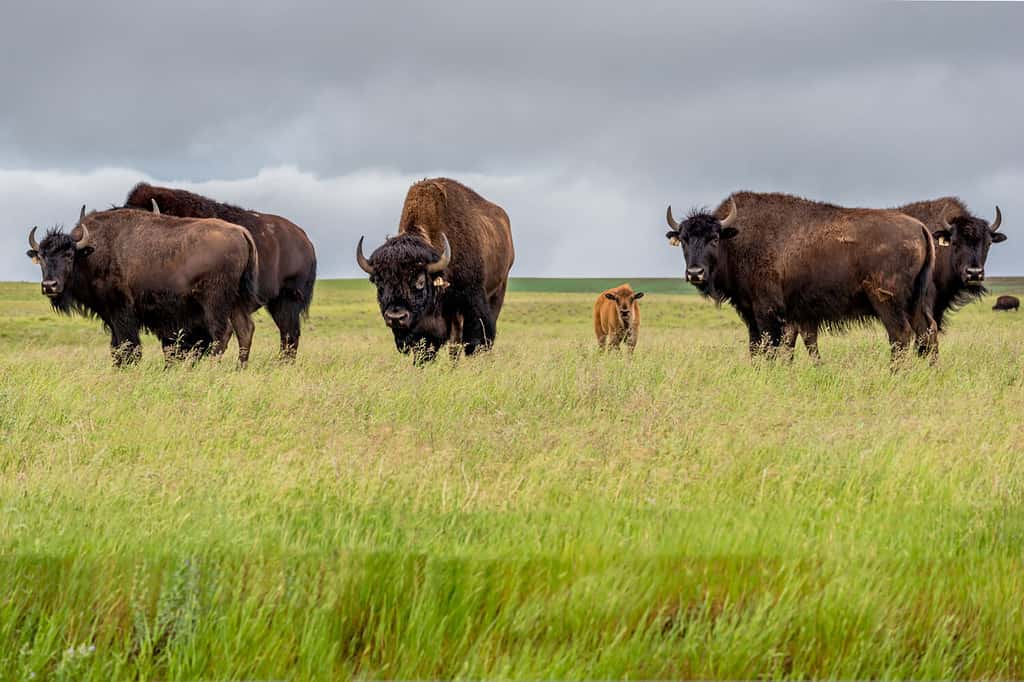
Turner Ranches claims a bison herd numbering 45,000 individuals!
©Nancy Anderson/Shutterstock.com
Bison Conservation
While bison are no longer threatened with extinction due to incredible preservation efforts, they struggle with other difficulties. For one, diseases often threaten the bison populations in and around Yellowstone. Furthermore, decreased genetic diversity causes homogeneity among bison populations, which can result in reduced immunity to environmental changes.
Luckily, bison remain protected in Yellowstone due to the Yellowstone Forever project. Yellowstone Forever works to conserve natural features and animals in the Yellowstone area. The organization aims to connect bison to surrounding Native American tribes, promoting their cultural and ecological significance. Just under 300 bison have been transferred to tribes across the Great Plains, which has helped Native American groups and bison alike.
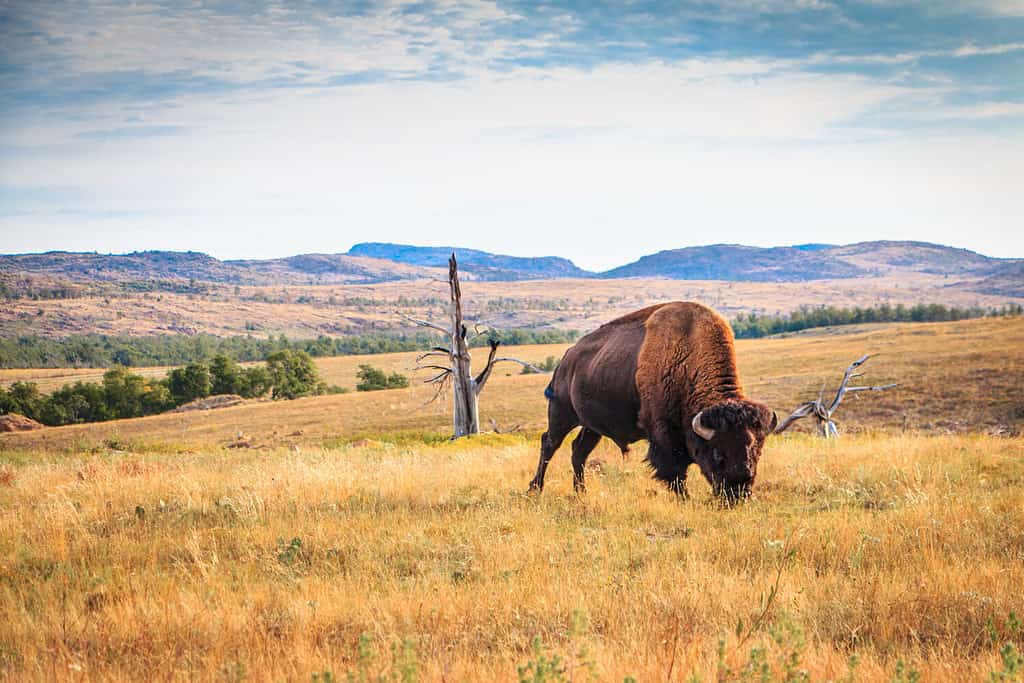
Yellowstone Forever connects bison to Native American tribes across the Great Plains.
©angie oxley/Shutterstock.com
The photo featured at the top of this post is © Gjeterhund Photography/Shutterstock.com
Thank you for reading! Have some feedback for us? Contact the AZ Animals editorial team.



